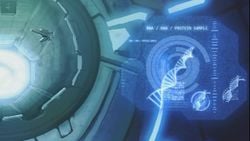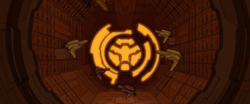Conservation Measure
From Halopedia, the Halo wiki
- "The Conservation Measure is the only sweet note in this discordant symphony we've arranged. It's the only constructive activity in decades of destruction."
- — Unknown Forerunner individual, likely the Librarian[1]
The Conservation Measure,[1][2][3] also known as the Library Project,[4] was a massive undertaking by the Forerunners to index and preserve biological diversity in the Milky Way Galaxy before and during the Forerunner-Flood war.
History[edit]
Background[edit]
When the possibility of the Halo Array was first proposed, the Librarian responded with outrage at the Builders' idea of defeating the Flood by committing galactic genocide, and petitioned Master Builder Faber and the Council to take measures to preserve the galaxy's life-forms in the event of the Halo Array's firing. As the Lifeworkers could halt medical science if they abandoned their duties in protest, Faber concluded that it would be less expensive to give in to the Librarian than fight her, so he agreed to her request.[5] As a result, the installations involved in the Halo Array, including the Halos themselves as well as the Arks which produced the rings—first the greater Ark and later Installation 00—were constructed to have surface conditions suitable for varying types of life, enabling the Lifeworkers to use them as biological preserves.
Indexing[edit]
Due to the limited space on their installations and ships, only a small number of the indexed beings were maintained as live specimens: the majority were reduced, storing their genetic and neural patterns as data until the repopulation of their respective homeworlds.[6] A variety of other facilities aboard the installations, including the Libraries, were used to catalog and study the specimens.[3] There were quite a few problems at first, mainly with regards to categorizing the races into specific categories.[4]
Although the Conservation Measure spanned several millennia, escalating into a more widespread evacuation effort during the Forerunner-Flood war, the sheer number of planets in the galaxy meant that the Lifeworkers never had time or the resources to save even remotely all species. A total of 123 sapient, technologically-capable species inhabiting the three million worlds within the Forerunners' ecumene had been indexed by the project at time of the evacuation of Earth,[7] roughly four years before the end of the war.[8] However, the Lifeworkers may have had to prioritize the preservation of some of these species over others due to their limited resources,[7] and a number may have perished with the destruction of the major preserves on the greater Ark and Omega Halo.[9] On many of the indexed worlds, only a fraction of the sentient fauna would survive; on Earth, for example, only a thousandth of the large species could be saved according to pre-Array projections.[10]
Research on the Flood in an attempt to find a means to defeat the parasite was an integral aspect of the Conservation Measure. For safety, the Conservation Measure dictated that Flood research facilities be constructed in remote locations.[11] Toward the end of the Flood conflict, the Master Builder began to alter his pact with the Librarian and authorized the use of the Lifeworkers' biological specimens on the Halos for extended experimentation on the Flood.[12] Humans, in particular, were subjected to rigorous tests on Installation 07, due to the supposed immunity they appeared to exhibit to Flood infection. These experiments later proved to be in vain, however, with the Primordial's revelation that no human was ever truly immune to the Flood.[13] The fate of the human species continued to hang in the balance throughout the endgame of the conflict: after the Ur-Didact composed the most significant human population stored on Omega Halo, the Lifeworkers were forced to retrieve additional specimens from the nearly empty Earth in order to restore a sustainable population.[14]
Reseeding[edit]
After the firing of the Halo Array and the subsequent defeat of the Flood, the surviving Lifeworkers on the Ark, under the leadership of the new Lifeshaper, Chant-to-Green, began the process of repopulating the galaxy in a stage referred to as the reintroduction, sending all the races back to their respective homeworlds.[4]
While a success, the Conservation Measure also sent each race back to a Tier 7 scale, forcing the sentient races to start over.[4] The period directly after the reintroduction was referred to as the "dark time", as some of the indexed species never recovered and subsequently became extinct.[15] The Librarian estimated that extinction events and irreparable environmental damage would occur on at least 18 worlds, with post-reseeding cataclysms on 31 worlds.[16] Two reintroduced races—the San'Shyuum and Sangheili—would end up worshiping the Forerunners as gods, something the Forerunners hardly anticipated. The data concerning the Conservation Measure was preserved at the Ark, and was still preserved as late as 2552, a revelation which surprised 343 Guilty Spark.[16]
On June 7, 2560, the Master Chief, Joyeuse and Lucas Browning found preserved specimens from the Conservation Measure in the Lifeworker Archive on Installation 07. Accessing the data, Joy found the specimens preserved not only in lifeform, but in complete DNA sequence as well. Joy called the scale of the preservation extraordinary with plants, creatures and ecosystems.[17] Browning wondered why so many specimens had been left behind and suggested that the Forerunners selectively picked which species survived and which ones didn't. Joy theorized that anything that the Forerunners had deemed too deadly or too powerful they stored in the Archive on Zeta Halo.[18]
Gallery[edit]
Cataloged lifeforms being loaded into a Keyship.
List of appearances[edit]
- Halo: The Flood (First appearance)
- Halo 3
- Halo: Legends
- Halo: Cryptum
- Halo: Combat Evolved Anniversary
- Halo: Primordium
- Halo 4
- Halo: Silentium
- Rebirth
- Halo: Broken Circle (Mentioned only)
- Halo 2: Anniversary (Mentioned only)
- Halo Mythos (Mentioned only)
- Halo: Shadows of Reach
- Sacrifice (Mentioned only)
- Halo: Point of Light (Mentioned only)
- Halo: Epitaph (Mentioned only)
- Halo: Edge of Dawn
Sources[edit]
- ^ a b Iris, Episode 4: The Great Connection
- ^ Halo: The Essential Visual Guide, page 14
- ^ a b Halo: Combat Evolved Anniversary - Library: Activation Index
- ^ a b c d Halo: The Flood: Adjunct
- ^ Halo: Cryptum, page 274
- ^ Halo: Silentium, pages 29, 57
- ^ a b Halo: Silentium, page 18
- ^ Halo: Silentium, page 197
- ^ Halo: Silentium, page 307
- ^ Halo: Silentium, page 27
- ^ Halo 2: Anniversary, multiplayer map Lockdown description
- ^ Halo: Cryptum, page 334
- ^ Halo: Primordium, pages 364-365
- ^ Halo: Silentium, pages 316-317
- ^ Halo Waypoint: Bestiarum
- ^ a b Halo 3, Terminals
- ^ Halo: Edge of Dawn, chapter 28
- ^ Halo: Edge of Dawn, chapter 29



